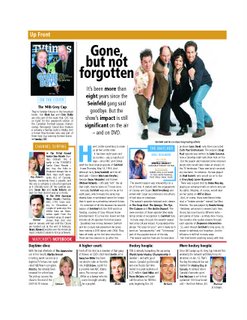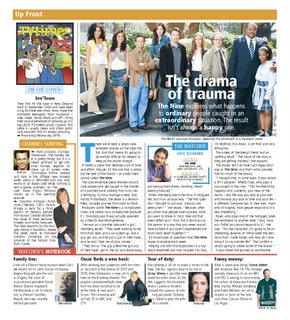
ON SCREEN:
MIDSEASON REPORT CARD
IF AT FIRST YOU DON'T SUCCEED, TRY, TRY AGAIN.
Starting from scratch
New Year’s Day always brings a clean slate to the TV business. Some networks will make the most of that. Others will just give us more of the same old stuff.
By Eric Kohanik
You may not realize it, but you’ve just been through hell.
Well, it wasn’t REALLY hell. It was just the worst week of the entire TV year.
There are a lot of things in the REAL world that are far more horrific to endure than that, of course. For the TV business, though, the week between Christmas Day and New Year’s Day is always a truly dark time.
It is often nicknamed “The Dead Zone.” It’s the week when such things as The Kennedy Center Honors and the start of the World Junior Hockey Championships always end up being the best things on TV.
Fortunately, it always seems darkest before the dawn. And things start to perk up somewhat this week, when New Year’s Eve trots out its array of celebratory specials, while New Year’s Day serves up everything from The Tournament of Roses Parade to that annual plethora of college-bowl games.
New Year’s Day isn’t really the midpoint of the TV season, but it is a time when the TV industry shrugs off the disasters of the fall and looks ahead to its hopeful newcomers.
The 2006-07 TV season started off as one of the most promising in years. That feeling didn’t last long, though.
New series began falling by the wayside in short order as network executives swung the cancellation axe swiftly – and often mercilessly.
CBS cancelled Ray Liotta’s crime series, Smith, after only three telecasts. It did the same with its replacement, a medical drama about brain surgery that starred Stanley Tucci but had the idiotic title of 3 LBS.
NBC, meanwhile, whacked Kidnapped and Twenty Good Years fairly quickly; Fox did thesame with Happy Hour, Vanished and, after waiting just a bit longer, Justice.
As for ABC, it opted to put Six Degrees and The Nine “on hiatus,” with vague promises of them returning.
As each TV season begins in the fall, American network executives keep preaching how they intend to show patience and let all of their good shows find their audiences. By New Year’s Day, of course, we find out they’re just a bunch of liars.
Canadian TV executives tend to go to the other extreme. Because it costs them so much to develop Canadian shows, they tend to keep almost anything they’ve produced on the air, even if virtually no one is watching. Most of CBC’s schedule is living proof of that.
At least New Year’s Day brings with it a clean slate and a new resolve to do better. That’s even more true in the TV business than it is in each of our personal lives.
Some networks are jumping into things right away this week; others are rolling out their new attractions and their stellar returnees over the next couple of weeks.
And, of course, all of them are promising to give us what they believe is truly the best.
For a little while, anyway.
















